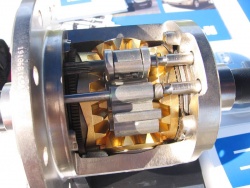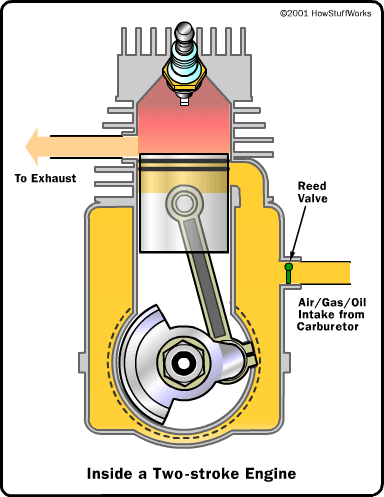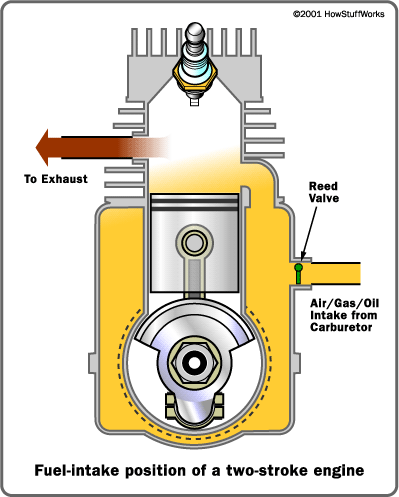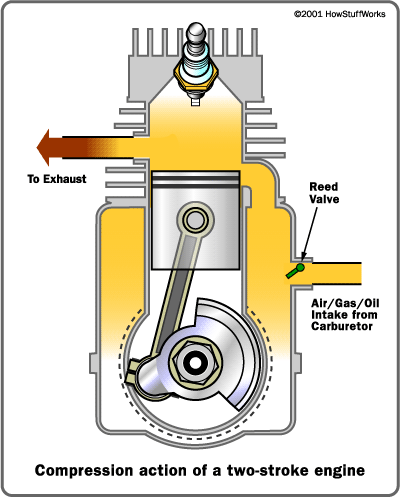The output shaft has round lobes mounted eccentrically, meaning that they are offset from the center line of the shaft. Each rotor fits over one of these lobes. The lobe acts sort of like the crankshaft in a piston engine. As the rotor follows its path around the housing, it pushes on the lobes. Since the lobes are mounted eccentric to the output shaft, the force that the rotor applies to the lobes creates torque in the shaft, causing it to spin.
Now let's take a look at how these parts are assembled and how it produces power.
Rotary Engine Assembly
A rotary engine is assembled in layers. The two-rotor engine we took apart has five main layers that are held together by a ring of long bolts. Coolant flows through passageways surrounding all of the pieces.
The two end layers contain the seals and bearings for the output shaft. They also seal in the two sections of housing that contain the rotors. The inside surfaces of these pieces are very smooth, which helps the seals on the rotor do their job. An intake port is located on each of these end pieces.

One of the two end pieces of a two-rotor Wankel engine
|
The next layer in from the outside is the oval-shaped rotor housing, which contains the exhaust ports. This is the part of the housing that contains the rotor.

The part of the rotor housing that holds the rotors
(Note the exhaust port location.)
|
The center piece contains two intake ports, one for each rotor. It also separates the two rotors, so its outside surfaces are very smooth.

The center piece contains another intake port for each rotor.
|
In the center of each rotor is a large internal gear that rides around a smaller gear that is fixed to the housing of the engine. This is what determines the orbit of the rotor. The rotor also rides on the large circular lobe on the output shaft.
Next, we'll see how the engine actually makes power.
Rotary Engine Power
Rotary engines use the four-stroke combustion cycle, which is the same cycle that four-stroke piston engines use. But in a rotary engine, this is accomplished in a completely different way.
If you watch carefully, you'll see the offset lobe on the output shaft spinning three times for every complete revolution of the rotor.
The heart of a rotary engine is the rotor. This is roughly the equivalent of the pistons in a piston engine. The rotor is mounted on a large circular lobe on the output shaft. This lobe is offset from the centerline of the shaft and acts like the crank handle on a winch, giving the rotor the leverage it needs to turn the output shaft. As the rotor orbits inside the housing, it pushes the lobe around in tight circles, turning
three times for every one revolution of the rotor.
As the rotor moves through the housing, the three chambers created by the rotor change size. This size change produces a pumping action. Let's go through each of the four strokes of the engine looking at one face of the rotor.
Intake
The intake phase of the cycle starts when the tip of the rotor passes the intake port. At the moment when the intake port is exposed to the chamber, the volume of that chamber is close to its minimum. As the rotor moves past the intake port, the volume of the chamber expands, drawing air/fuel mixture into the chamber.
When the peak of the rotor passes the intake port, that chamber is sealed off and compression begins.
Compression
As the rotor continues its motion around the housing, the volume of the chamber gets smaller and the air/fuel mixture gets compressed. By the time the face of the rotor has made it around to the spark plugs, the volume of the chamber is again close to its minimum. This is when combustion starts.
Combustion
Most rotary engines have two spark plugs. The combustion chamber is long, so the flame would spread too slowly if there were only one plug. When the spark plugs ignite the air/fuel mixture, pressure quickly builds, forcing the rotor to move.
The pressure of combustion forces the rotor to move in the direction that makes the chamber grow in volume. The combustion gases continue to expand, moving the rotor and creating power, until the peak of the rotor passes the exhaust port.
Exhaust
Once the peak of the rotor passes the exhaust port, the high-pressure combustion gases are free to flow out the exhaust. As the rotor continues to move, the chamber starts to contract, forcing the remaining exhaust out of the port. By the time the volume of the chamber is nearing its minimum, the peak of the rotor passes the intake port and the whole cycle starts again.
The neat thing about the rotary engine is that each of the three faces of the rotor is always working on one part of the cycle -- in one complete revolution of the rotor, there will be three combustion strokes. But remember, the output shaft spins three times for every complete revolution of the rotor, which means that there is one combustion stroke for each revolution of the output shaft.
Differences and Challenges
There are several defining characteristics that differentiate a rotary engine from a typical piston engine.
Fewer Moving Parts
The rotary engine has far fewer moving parts than a comparable four-stroke piston engine. A two-rotor rotary engine has three main moving parts: the two rotors and the output shaft. Even the simplest four-cylinder piston engine has at least 40 moving parts, including pistons, connecting rods, camshaft, valves, valve springs, rockers, timing belt, timing gears and crankshaft.
This minimization of moving parts can translate into better reliability from a rotary engine. This is why some aircraft manufacturers (including the maker of Skycar) prefer rotary engines to piston engines.
Smoother
All the parts in a rotary engine spin continuously in one direction, rather than violently changing directions like the pistons in a conventional engine do. Rotary engines are internally balanced with spinning counterweights that are phased to cancel out any vibrations.
The power delivery in a rotary engine is also smoother. Because each combustion event lasts through 90 degrees of the rotor's rotation, and the output shaft spins three revolutions for each revolution of the rotor, each combustion event lasts through 270 degrees of the output shaft's rotation. This means that a single-rotor engine delivers power for three-quarters of each revolution of the output shaft. Compare this to a single-cylinder piston engine, in which combustion occurs during 180 degrees out of every
two revolutions, or only a quarter of each revolution of the crankshaft (the output shaft of a piston engine).
Slower
Since the rotors spin at one-third the speed of the output shaft, the main moving parts of the engine move slower than the parts in a piston engine. This also helps with reliability.
Challenges
There are some challenges in designing a rotary engine:
- Typically, it is more difficult (but not impossible) to make a rotary engine meet U.S. emissions regulations.
- The manufacturing costs can be higher, mostly because the number of these engines produced is not as high as the number of piston engines.
- They typically consume more fuel than a piston engine because the thermodynamic efficiency of the engine is reduced by the long combustion-chamber shape and low compression ratio.
http://tariqhafez.blogspot.com/




















































